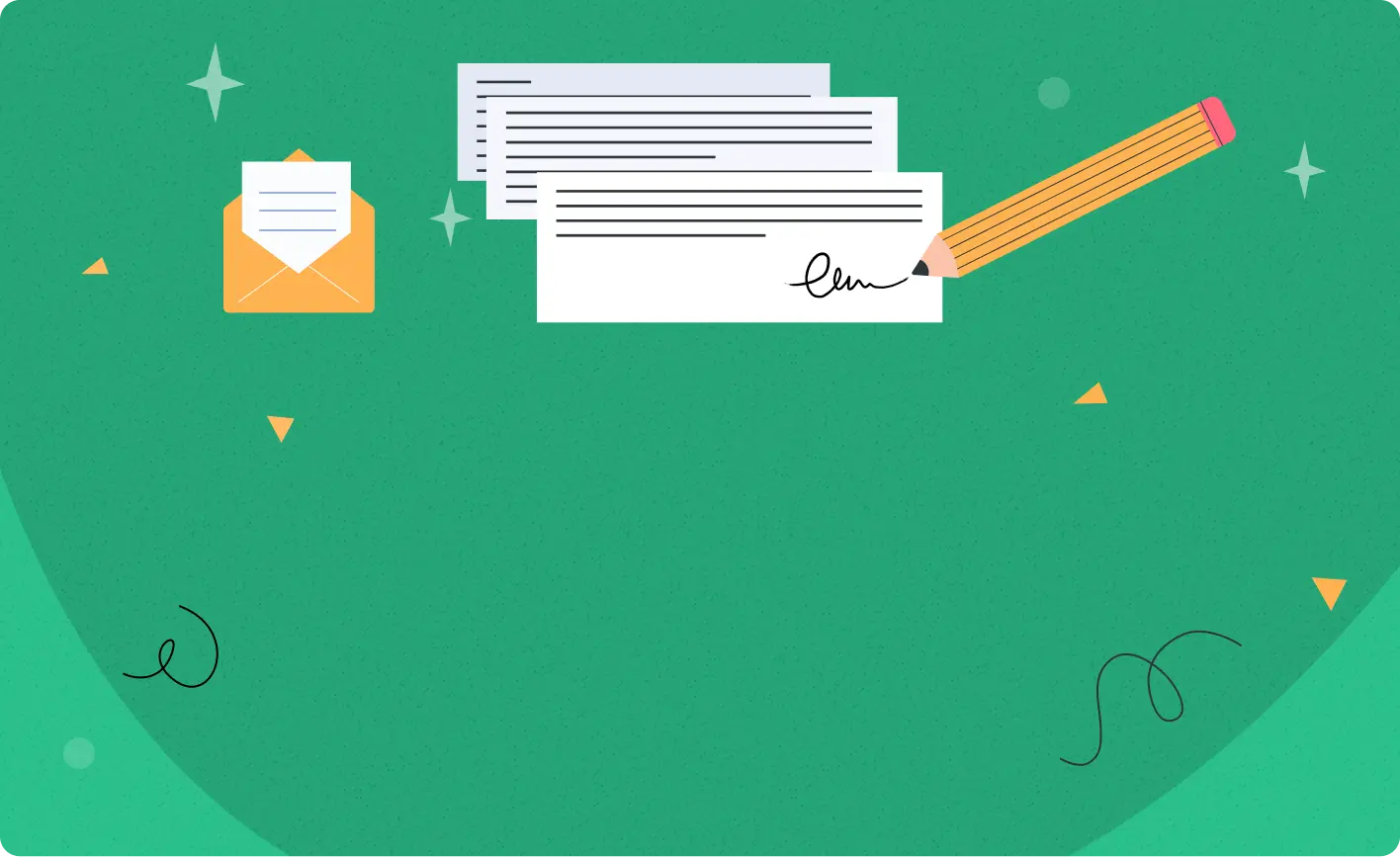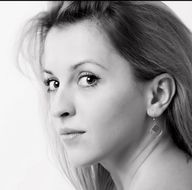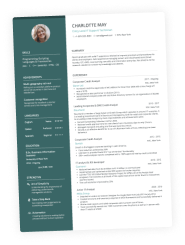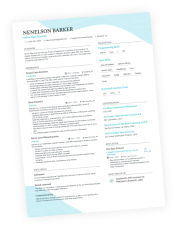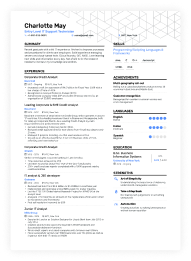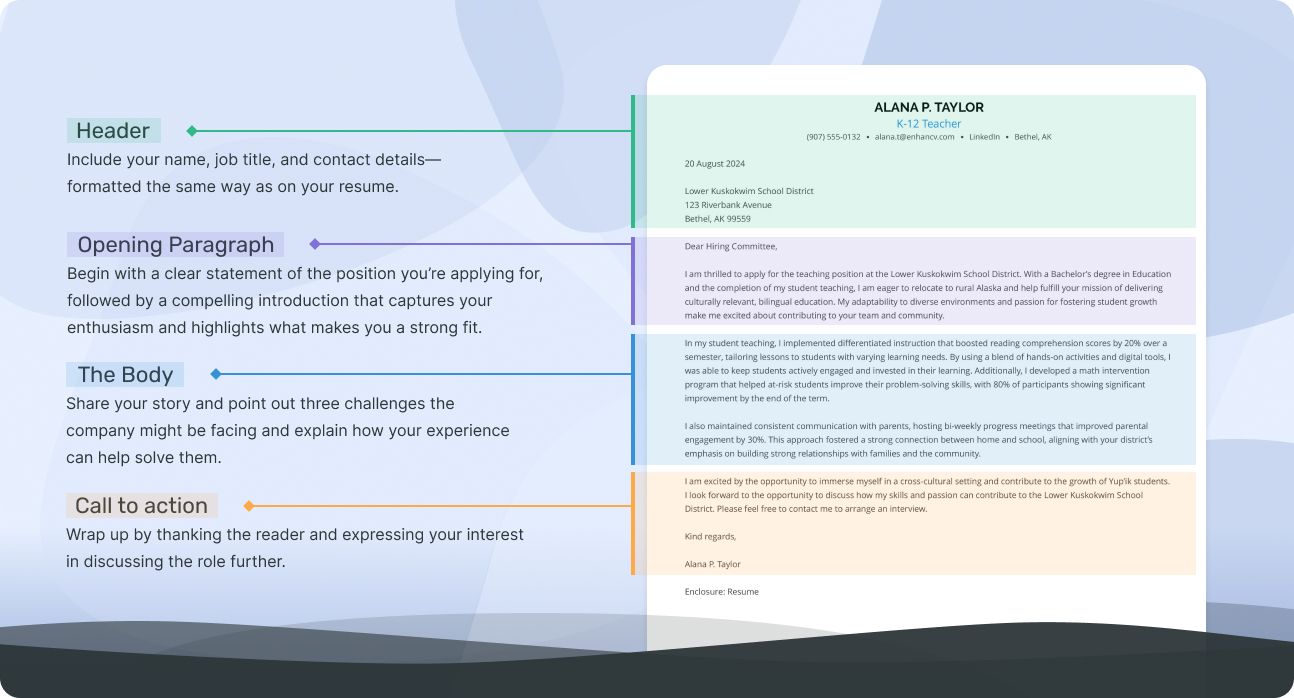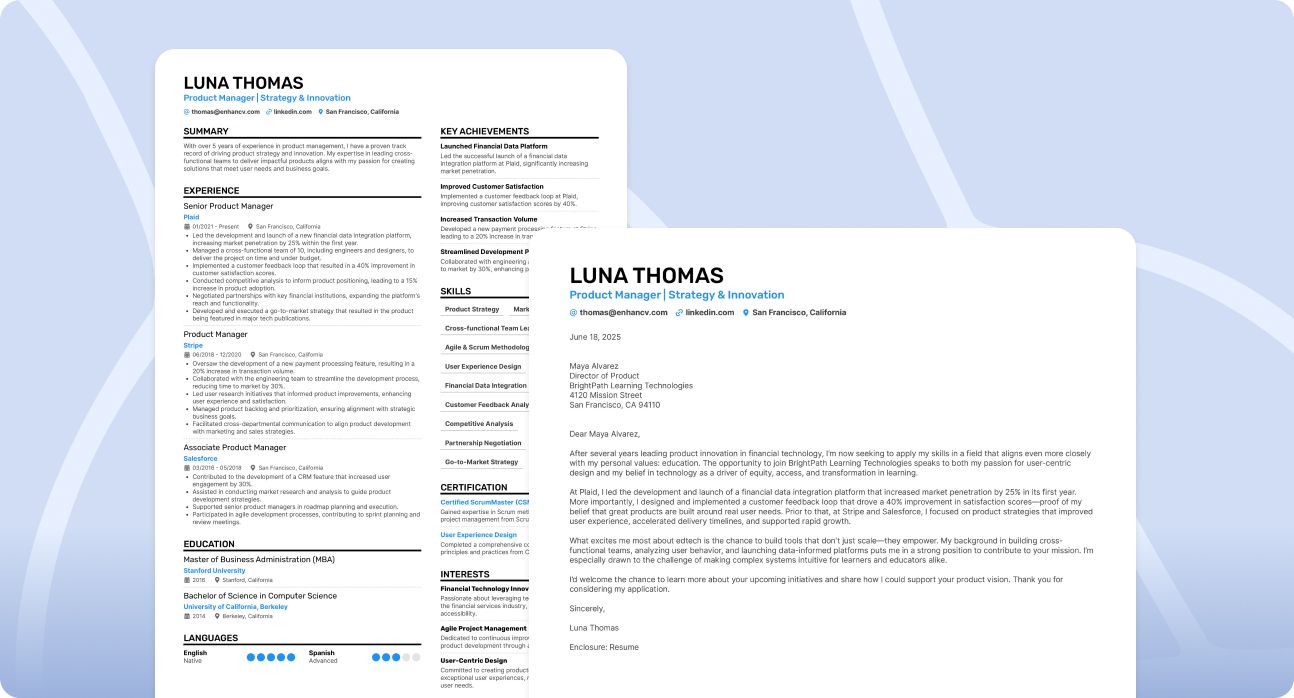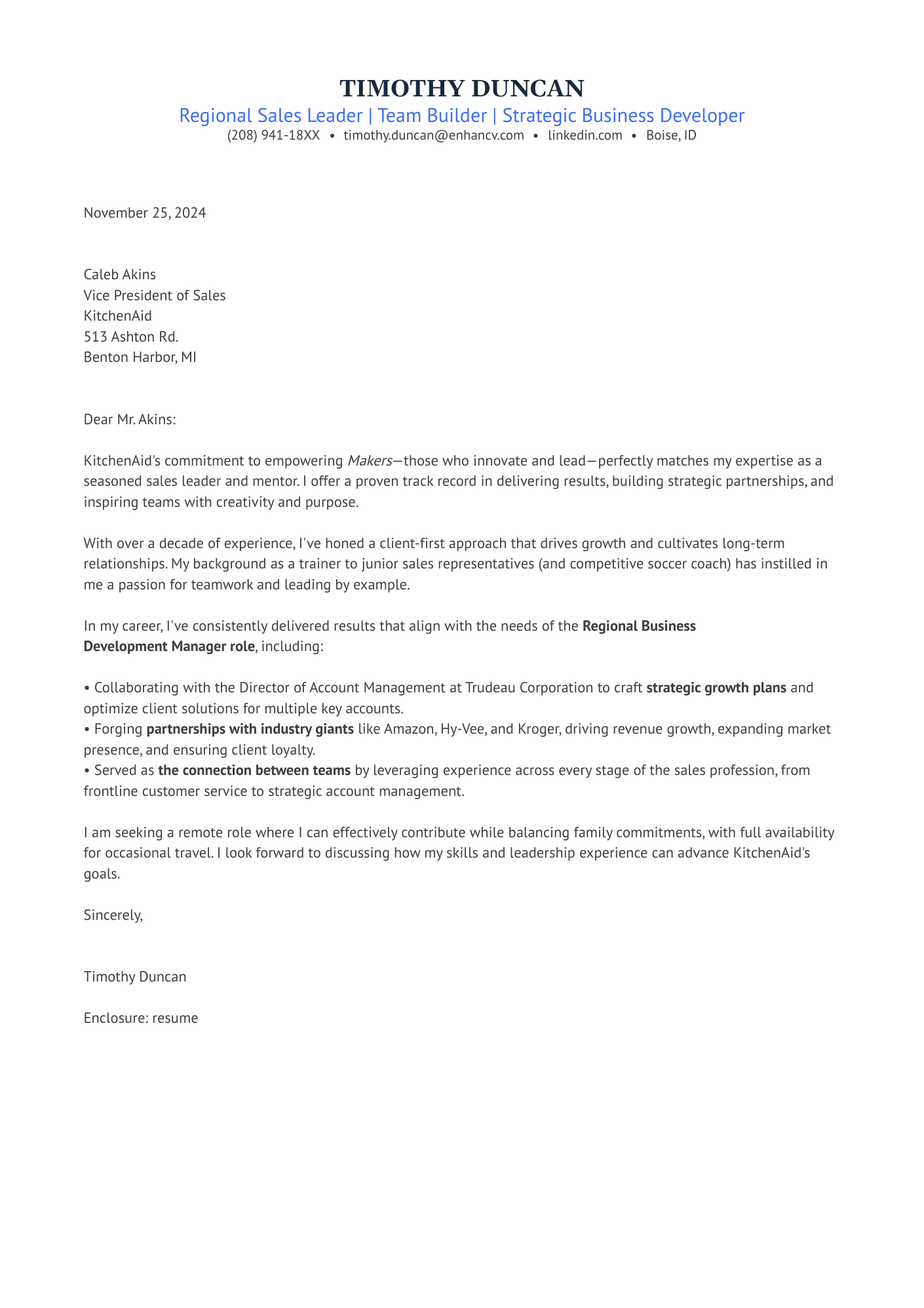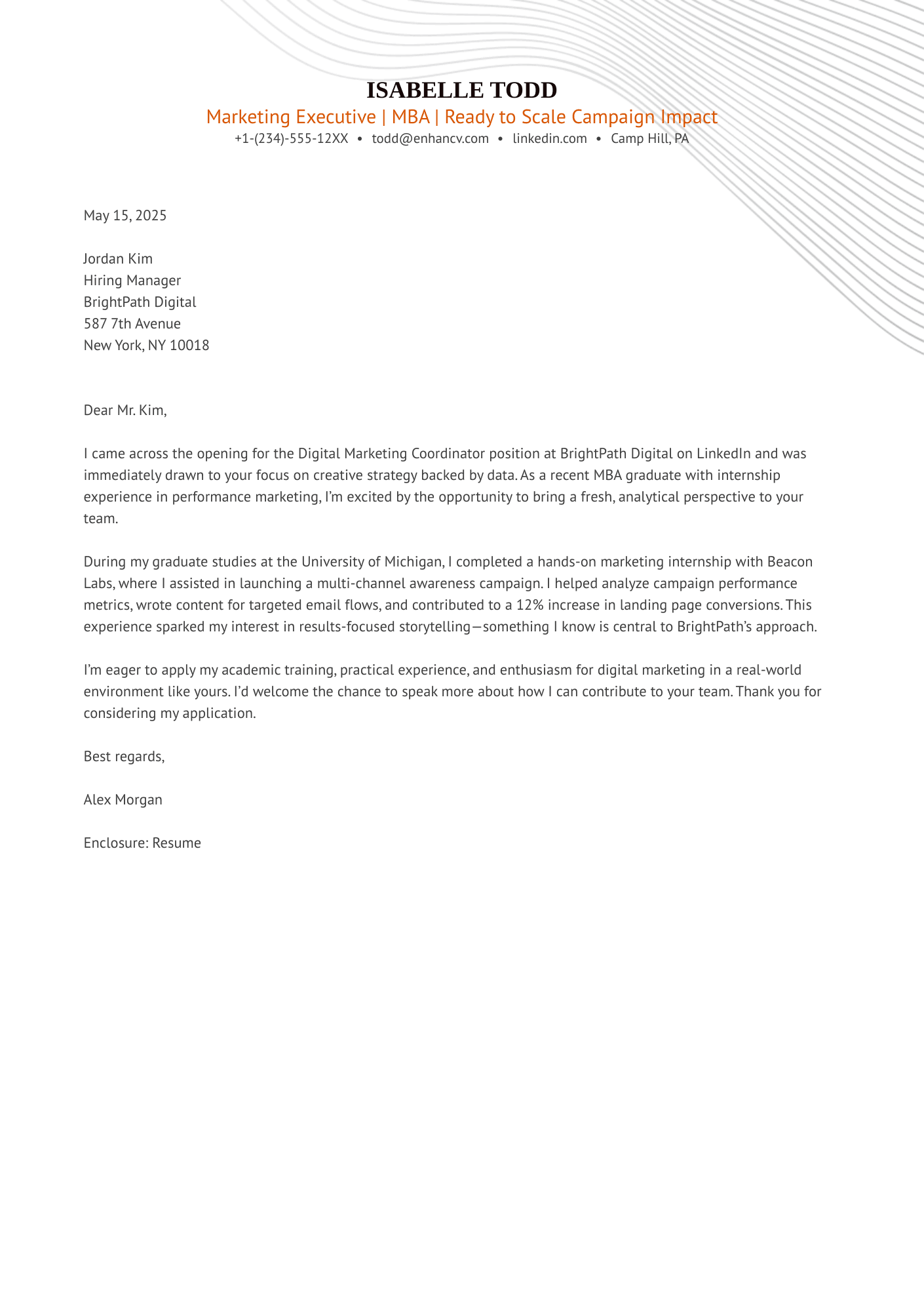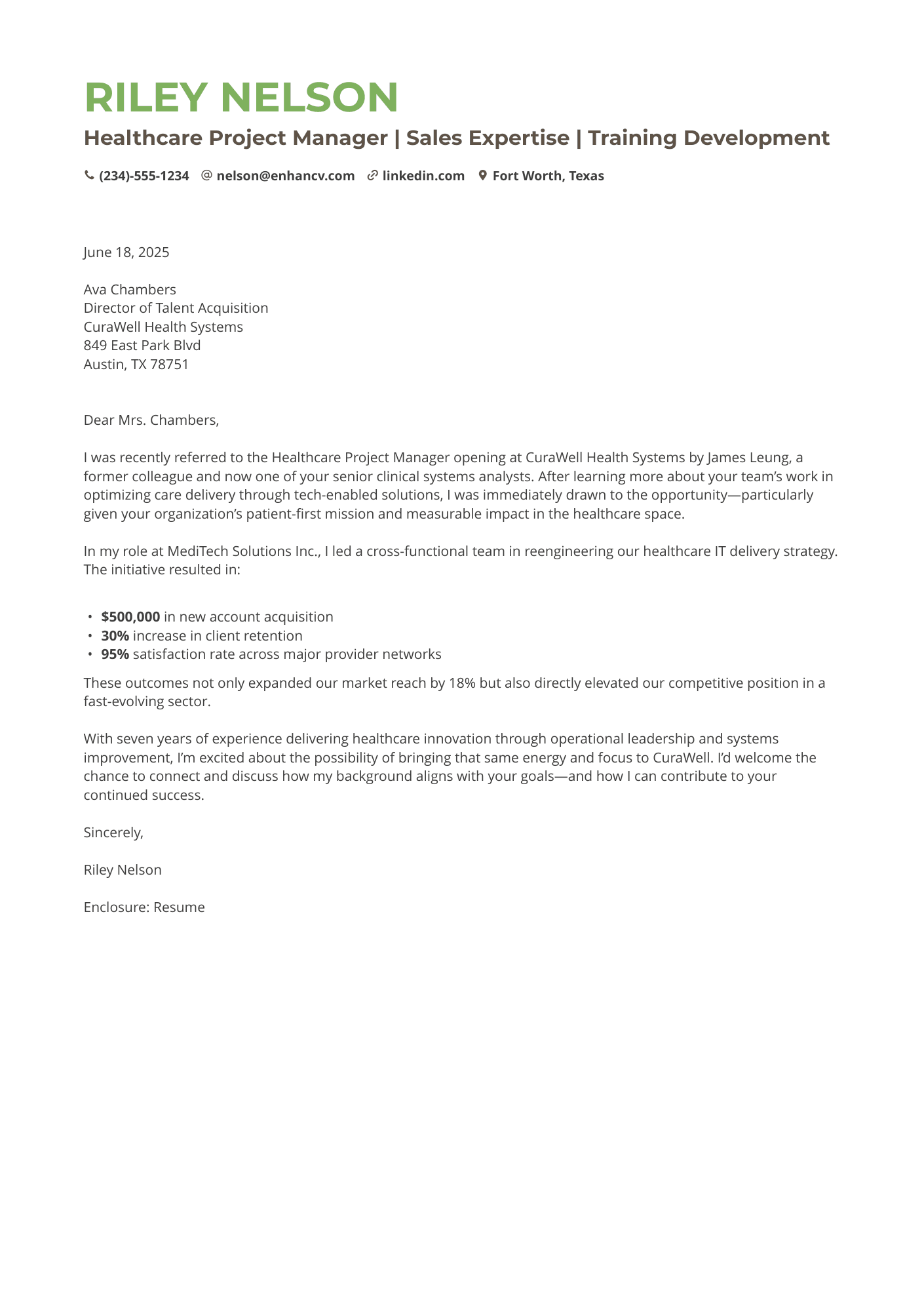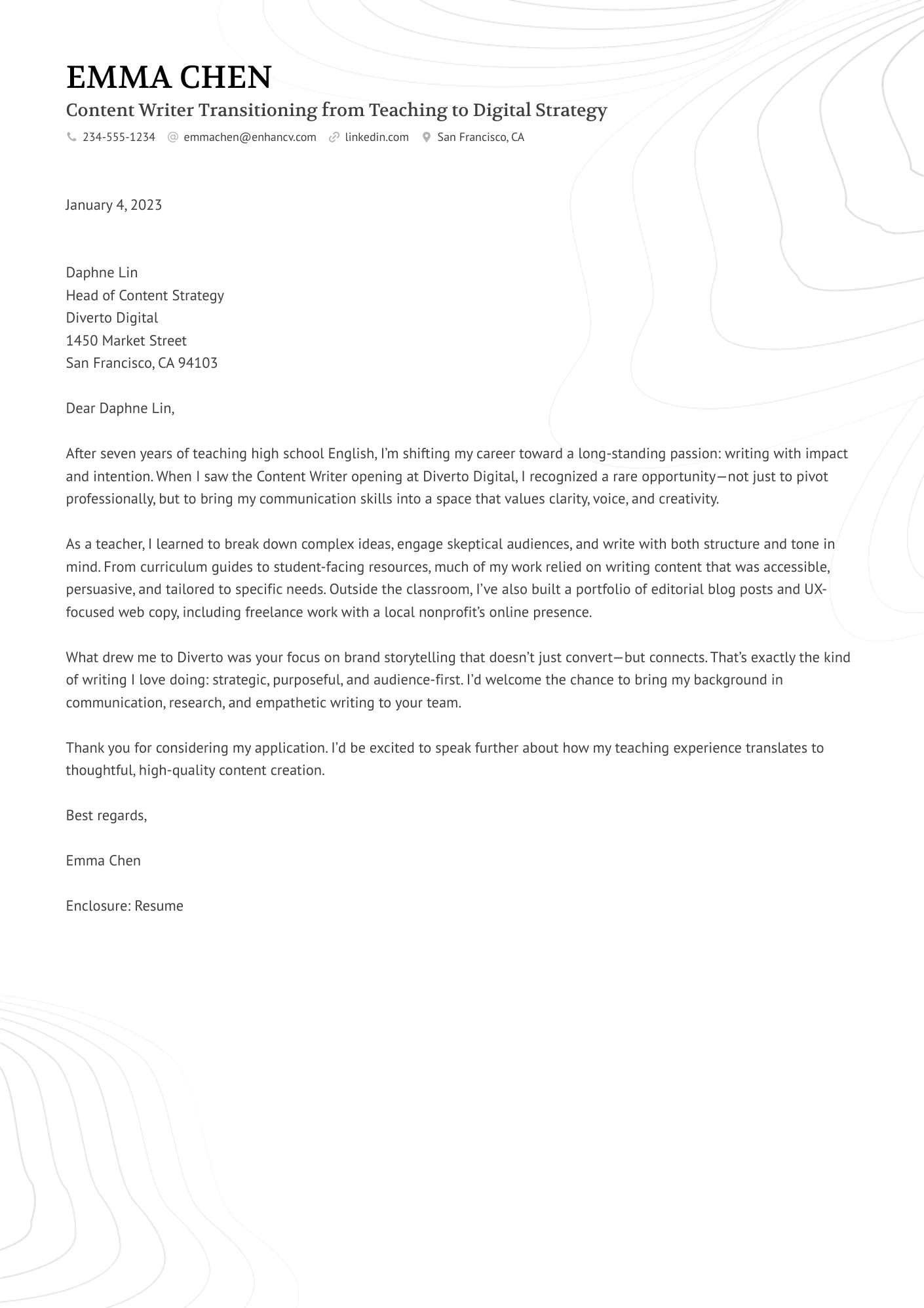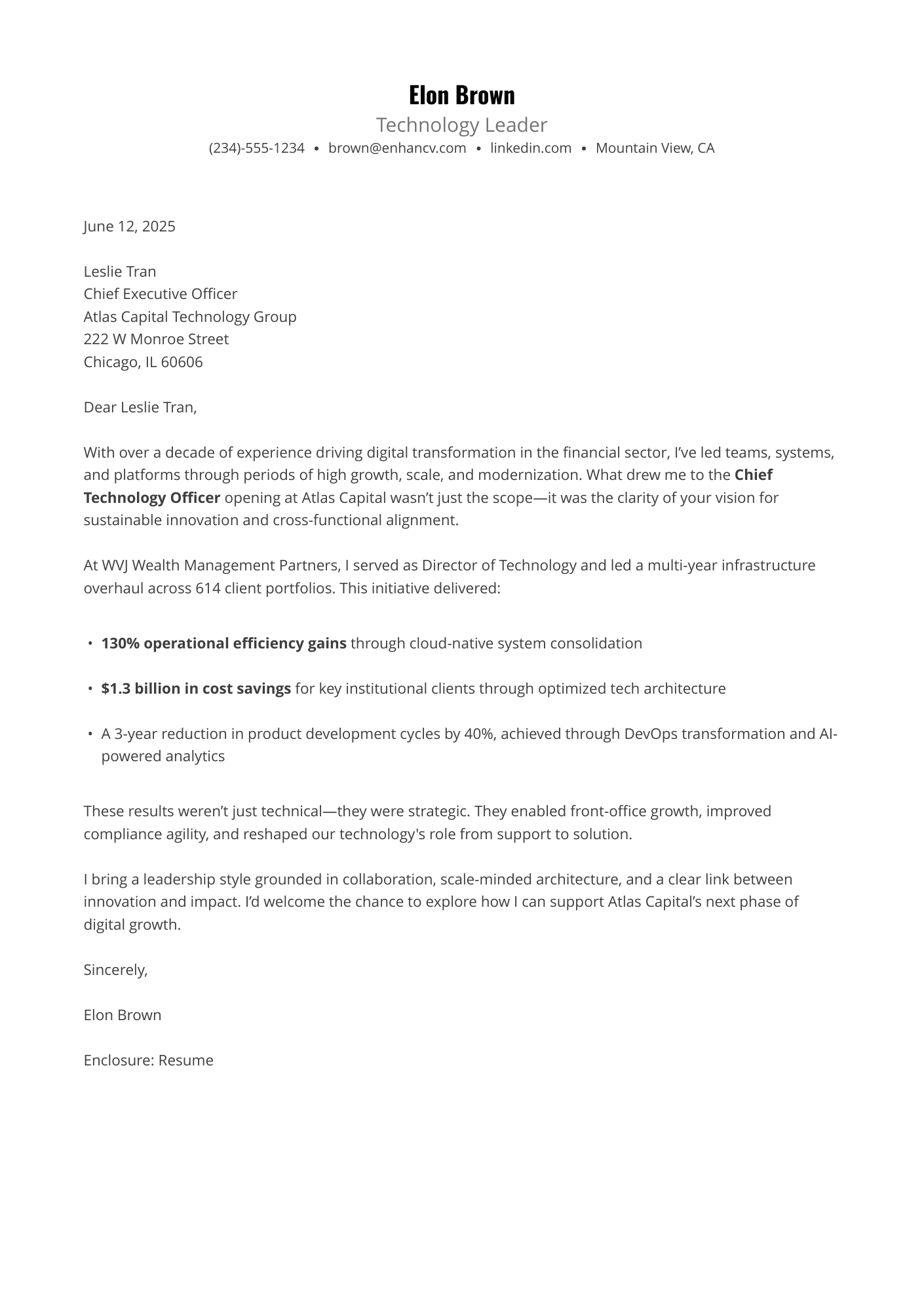One of my first questions when I entered the industry was: Do people still write cover letters? I genuinely believed no one ever got an interview call because of one—it was the resume or the tasks that sealed the deal.
I didn’t get cover letters, that’s the truth. And like many job seekers, I often wondered: What makes a good cover letter? Can a few paragraphs of Arial 10 pt really catch a hiring manager’s attention?
But over time—and especially after becoming a Certified Professional Résumé Writer (CPRW)—my perspective started to shift. The best cover letters I read weren’t formulaic—they were flexible, personal, and true to the person writing them. That’s what made them strong. And it made me even more curious: What does a great cover letter truly look like?
Let’s break that down—both in terms of formatting and content.
Key takeaways
- A great cover letter is a one-page document that balances clarity, structure, and personality, putting your skills and experience center stage.
- How your cover letter looks matters just as much as what it says, especially when it comes to layout, spacing, and alignment.
- Different career stages call for different tones and strategies, but every strong cover letter stays visually consistent with your resume.
- Clean formatting, purposeful structure, and careful proofreading go a long way in making a lasting impression.
- Enhancv’s Cover Letter Builder makes it easy to build visually aligned cover letters.
What does a cover letter look like? The quick answer
Imagine a single, focused page that feels as intentional as it looks—neat, professional, and built to be scanned in 60 seconds or less. A great cover letter isn’t flashy or wordy. It’s a strategic document with one goal: to explain why you’re a strong fit and spark enough interest to land an interview.
It’s not just about what you say—it’s how you present it, too. A well-formatted cover letter shows clarity, confidence, and care.
Here’s what that looks like at a glance:
- One page only: Short, sharp, and easy to scan in under a minute.
- Professional, easy-to-read font: Think Arial, Ribik, or Times New Roman, 10-12 pt. Simple, readable, and exactly what hiring managers expect.
- One-inch margins and left-aligned text: Clear formatting that doesn’t distract from your message.
- Clear, structured layout: A header with your contact info, a personalized greeting, a compelling intro, one or two focused body paragraphs, and a strong closing call to action.
- Saved as a PDF: So it opens cleanly on any device, exactly as you intended.
That’s the visual baseline. Make it clean, consistent, and unmistakably you.
The cover letter above was created using Enhancv’s Cover Letter Builder.
We believe your cover letter and resume should work together—visually and strategically. That’s why our builder helps you create cover letters that match your resume’s design, reinforcing your personal brand and keeping your application consistent from start to finish.
Want help with what to say beyond the looks? Check out our full guide on how to write a cover letter—it’s all about crafting content that matches the format in strength.
How your cover letter looks says more than you think
So, what does a cover letter look like next to a resume? If it’s doing its job, the answer is simple: like it belongs there. The two should share the same DNA—matching fonts, aligned styling, and a consistent tone of voice. Together, they tell the hiring manager that you're thoughtful, prepared, and serious about how you present yourself.
Before anyone reads a single word, your cover letter has already started speaking. Layout, spacing, structure—they all shape the reader’s first impression. That’s not just aesthetics; it translates into one powerful quality—professionalism.
A cluttered layout reads as careless. A clean one reads as capable.
Author’s take
Let’s walk through how that quality shows up on the page.
Formatting tips for your cover letter
- Leave room to breathe: Use one-inch margins on all sides to keep the layout open and easy on the eyes. No one wants to read a wall of text.
- Stick to a single page: One page (around 250-400 words) tells the recruiter: I know what matters, and I can say it clearly.
- Choose one font, and let it lead: Use a clean, professional typeface like Arial or Volkhov in 10 or 12 pt. Ideally, it has to be the same as your resume font for a cohesive, polished look.
- White space is your friend: Separate each section with consistent line spacing. Think single-spaced text with one line between paragraphs. It creates visual balance.
- Align left, always: No need to center or justify your text. Left alignment is easier to scan and expected in professional documents.
- Don’t use color unless it matches your resume: A soft accent (like a line or your name in a muted shade) can work—if it’s part of a consistent visual style.
- Avoid graphic elements. No icons, no tables, no bold design flourishes that fight for attention. Let the layout support your message, not distract from it.
In my work as a CPRW, I’ve created and reviewed hundreds of cover letter samples. The strongest ones weren’t just well-written—they looked intentional. The formatting matched the resume. The spacing was comfortable. The design felt like the applicant had taken ownership of their brand.
And honestly? I can often tell who’s serious before I read a single line.
Here’s a cover letter example that shows strong, consistent formatting.
Check out our library of cover letter examples, each styled to match a resume while highlighting different tones and industries.
What does a cover letter look like structurally?
If visual formatting is about polish, structure is about flow—how each section leads into the next and guides the reader through your message. Think of structure as the scaffolding behind that professional first impression. Each element—from header to sign-off—signals intention. If it looks predictable in the best way, it reads as prepared.
Here’s how your cover letter should take shape on the page:
Core sections of a well-crafted cover letter
- Header: This should mirror the header on your resume: name, phone number, professional email, LinkedIn (if relevant). No photos, no flair—just clarity.
- Date: Two or three lines below the header, add the date, aligned to the left. Format it simply: “June 15, 2026.”
- Hiring manager’s details: Two or three lines below, include the recipient’s name, job title, company name, and full address. This is standard business correspondence etiquette.
- Proper salutation: Avoid “Dear Sir or Madam” or “To whom it may concern.” Instead, use a real name whenever possible: “Dear Jordan Kim” or “Dear Hiring Manager,” followed by a comma or a colon.
- Opening paragraph: Two lines below the salutation, briefly introduce yourself and state the position you’re applying for. Be clear and confident.
- Body paragraph(s): Show alignment with the company’s values, tone, or mission. Highlight how you can contribute, using specific examples—not a copy-paste of your resume.
- Closing paragraph: Wrap up with a strong call to action. Thank the reader and express interest in the next step.
- Ending: Sign off with a formal closing like “Sincerely” or “Best regards,” followed by your name, spaced two to three lines below.
- Enclosure: If you’re attaching your resume, include “Enclosure: Resume” beneath your name.
A strong cover letter doesn’t just look good—it reads effortlessly, because the structure does the heavy lifting. Every section has its place, and every line has its job.
Still wondering what a great one actually looks like? Below are a few real-world examples that bring everything we’ve discussed to life.
Real examples of what a great cover letter looks like at every career stage
From corporate to creative, formal to bold, these examples show the range of what a strong, modern cover letter can look like when it’s done right.
Entry-level cover letter
For students, recent graduates, or those with less than two years of experience, your cover letter should project potential, personality, and purpose. You might not have a long resume, but that’s not what this is about. A great entry-level cover letter shows that you’re thoughtful, motivated, and ready to grow.
Here’s what it should look and sound like:
- Use case: First jobs, internships, graduate roles, or applying without direct experience.
- Tone: Confident, eager, and future-facing—but never desperate or overly casual.
- Message focus: Emphasize transferable skills, education, and enthusiasm for the company or industry.
- Voice: Personal but polished. Let your values and curiosity come through.
- Design: Clean and minimal, with plenty of white space—no fancy elements needed. Match your resume’s font and header for consistency.
This is how a cover letter looks when you don’t have years of experience but do have potential.
Mid-level cover letter
This stage is all about traction. If you have three to ten years of experience, your cover letter should reflect that you know what works, without overselling. A strong mid-level resume or cover letter balances results with relevance. It shows that you’re not just experienced, but aligned with where the company is going.
When writing yours, keep the following factors in mind:
- Use case: Career progression, lateral move to a stronger brand, applying through a referral, or stepping into a slightly more strategic role.
- Tone: Confident, targeted, and professional. This demonstrates ownership without sounding overreaching.
Message focus: Results, process, and fit. Quantify what you’ve done and explain how it translates to the new role. - Voice: Clear and polished, with glimpses of your working style and management habits.
- Design: Matched to your resume style. You may use a subtle accent or divider, but prioritize clarity and clean structure.
Here’s an example:
Career change cover letter
Changing careers doesn’t mean starting over—it means repositioning what you already know. A strong career change cover letter tells a clear story: why you’re pivoting, how your past experience supports it, and why you’re a fit.
Consider these tips:
- Use case: Switching to a new industry, role, or function (e.g., teacher to UX designer, marketing to product, operations to HR).
- Tone: Intentional, forward-focused, and confident—show clarity, not uncertainty.
- Message focus: Reframe your background to highlight transferable skills and shared values—it’s like connecting the dots for the reader.
- Voice: Balanced and professional, with a narrative feel that explains the why behind your pivot.
- Design: Keep it clean and structured. Your formatting should reflect your readiness, so use alignment and typography to project control.
Here’s how this can look on a cover letter:
Executive-level cover letter
At the executive level, your cover letter is about value and leadership presence. It should feel like a natural continuation of your resume, reinforcing your strategic impact while signaling your readiness to shape direction and deliver results at scale.
It’s about saying the right thing, concisely, in a voice that reflects decisiveness and credibility.
Here’s what this should look and sound like:
- Use case: C-level or senior roles (Director, VP, Head of...), often in response to a recruiter outreach, referral, or discreet opening.
- Tone: Strategic, composed, and outcome-focused—more “this is what I can bring” than “this is what I want.”
- Message focus: Executive scope, measurable results, vision, and organizational fit.
- Voice: Polished, succinct, and confident—avoid fluff, and let the numbers and insight lead.
- Design: Conservative and clean, no visual noise. The formatting should support authority: consistent font hierarchy, no bold colors or stylistic distractions.
Below is an example of a CTO’s cover letter:
Want to start your own cover letter with the same visual style and structure? Explore Enhancv’s cover letter templates—easy to download in both TXT and image formats.
All you need to know about cover letter appearance
Even after writing hundreds of cover letters—as a job seeker and later as a CPRW—I still approach each one with curiosity. The content always varies, but some questions come up every single time.
Because the truth is: how your cover letter looks shapes how it’s read.
So let’s break down the visual basics—the things every great cover letter gets right, no matter the industry or experience level.
Length
Still wondering how long your cover letter should be? One page. That’s it. Somewhere between 250–400 words is the sweet spot. Just enough to tell your story, make a case, and get out before it starts sounding like a monologue.
When I review cover letters, the ones that get it right say just enough—and leave the reader wanting more. The ones that go off track usually spend too much time talking about the candidate, and not enough to the company.
So don’t just write for yourself—write with the reader in mind. Think of it as a gentle, strategic pitch: a way to market your way into the organization.
You can get as elaborate as you want to, but I always lean toward more of an email mentality. The longer the letter, the greater the potential for being screened OUT based on writing that strikes people the wrong way. There is no need to be prolific here; just be on-point, practical, and brief.
John Suarez, CPRW, and book author
Single vs double spacing
Go for single or 1.15 spacing for the body of your letter. Double spacing is rarely used, except in academic or legal submissions where it’s more of a formatting convention than a readability choice.
Give your cover letter room to breathe:
- Leave a line between each paragraph.
- Add a little extra space before your greeting and sign-off. It helps guide the reader’s eye. (You’ll find the exact line spacing tips in the formatting section above.)
It’s about rhythm. You don’t want the letter to feel crammed, but you also don’t want it to drift.
Using colors
You can use colors on your letter—just be intentional about it. A muted accent (your name or a horizontal line, for example) can make your application stand out just enough.
PRO TIP
The general rule is to match your cover letter design to the colors and style of your resume. If it’s just decorative, it’s better to hold back. At Enhancv, we make that easy by syncing your resume and cover letter templates, so everything looks cohesive without the design guesswork.
Cover letter photo—yes or no
In most cases, no. Unless you’re applying in an industry or region where that’s standard (like performing arts or some parts of Europe), a photo can feel out of place.
Your personality should come through in your writing, not your headshot.
The right paper for printed cover letters
If you’re printing your cover letter (and resume), go with 24 lb. or 32 lb. premium white paper—something heavier than standard printer paper, but still professional. Bright white or slightly off-white works best, and if you want to level up, choose a cotton or linen blend for subtle texture.
More importantly, print both documents on the same paper to keep things consistent. (Yes, people still notice that.)
PRO TIP
In the United States, the standard paper size is 8.5 x 11 inches. Stick to that unless the employer specifies otherwise.
Cover letter file format
How you submit your materials depends on the job’s requirements—some employers may ask for a Word doc or use an online application system. But unless it says otherwise, PDF is your safest, most professional bet.
It’s clean, consistent, and looks the same whether the recruiter opens it on their phone, laptop, or a second monitor at 9 a.m. on a Monday.
Nothing derails a strong cover letter faster than broken formatting.
A note on unusual cover letter designs
Yes, they’re out there. Horizontal layouts. Cover letters designed like press releases or newspaper clippings. Some even look like sleek one-pagers from a creative pitch deck. And in the right hands, for the right role, they can work.
But here’s the thing: these bold formats usually succeed when they’re backed by strong design instincts and a clear strategy. If you’re applying for a role in advertising, design, or a visual-first industry—and the company itself embraces unconventional branding—then there may be room to experiment.
Otherwise, don’t let style override substance. A clean, well-formatted cover letter that mirrors your resume is almost always the better move. It keeps the focus where it belongs—on what you bring to the role.
How to make your cover letter stand out
I’ll be honest: when I first started reading cover letters seriously, I assumed the impressive ones would be full of clever tricks—brilliant hooks, bold formatting, maybe even a quote or two. But after spending so much time reviewing and writing them, I realized something else entirely.
The best cover letters don’t try to impress. They connect.
They’re thoughtful, well-paced, and visually calm. They speak to the hiring manager without shouting. And they come from someone who clearly understands the job and how they fit into it.
If you’re still feeling hesitant—like I once was—here are a few things no one tells you, but every great cover letter quietly gets right:
- A good letter sounds like a person, not a template. Read it out loud. If it doesn’t sound like you, revise until it does.
- Don’t over-explain. Let the structure do the heavy lifting. A strong opening and two or three sharp quantified achievements often say more than three long paragraphs ever could.
Formatting isn’t cosmetic—it’s persuasive. When a layout is clean and easy to follow, it makes the content feel more credible. - Proofreading matters more than you think. A single typo can break momentum. Step away for an hour, then come back and read it with fresh eyes.
- Be consistent. Match your resume’s tone, style, and spacing. It’s a small thing that creates an impression of someone who finishes what they start.
- If it helps, don’t write from scratch. You’re not alone in this—tools like Enhancv’s free AI Cover Letter Generator exist for a reason.
Can AI help your cover letter look better?
Absolutely—if you use it with intention. Tools like AI writing assistants or Enhancv’s Cover Letter Builder can help you format your letter cleanly, check for consistency, and even improve tone or structure. Just remember: the tech is here to support your voice, not replace it.
Conclusion
A strong cover letter doesn’t have to be complicated—it just has to be clear, intentional, and genuinely yours. When it looks the part and reads with purpose, it does more than introduce you—it opens a door. And if you need a hand with layout or structure, Enhancv is here to make that part effortless.
